

2009 Report - Beijing
Introduction // Hangzhou // Beijing // Conclusion
Arrival
Arriving at Tsinghua University
After the two hour flight from Hangzhou Xiaoshan International Airport to Beijing Capital International, we were greeted by Professor Wang who was waiting for our arrival. We then took a bus to a nearby bus station to Tsinghua University. On the way to the bus station, we caught a glimpse of the famous Olympic National Stadium known as the Bird's Nest.

Figure B1: View of the Bird's Nest from the bus
After we arrived at the bus station, we took a taxi to the dorm building we would be staying at in Tsinghua University. We met our host student Jianhui Lin soon after and he helped us get settled in. Jianhui is a PHD candidate and the chair of the IEEE Electron Device Society (EDS) Tsinghua University student chapter. Jianhui first took us to the foreign student office to complete some final registration applications to obtain our school ID. We then went to housing office to obtain our room keys, followed by the bicycle rental booth to get a rental bike and finally we moved in to our rooms.
After unpacking, Jianhui took us to the nearest campus cafeteria for lunch. There we got to know each other and he gave us a brief outline of what we would be doing during our 3 and a half week stay. Unlike Hangzhou where we only had two host students, Jianhui explained that we would have a different volunteer for each scheduled event. All the volunteers are members of the IEEE EDS student chapter.
Tsinghua University Tour
The following day Jianhui gave us a tour of Tsinghua University to allow us to get familiarized with the university. Our tour began at our international dorm building and we rode our bicycles in a counterclockwise direction through the campus. We got to see the physics building, chemistry building and many other buildings. Along the way we also got to visit the on-campus zoo and we got to see the art exhibition at the Art building.

Figure B2: The Old Gate
We had the opportunity of going to see the Old Gate, which is the school symbol for Tsinghua University.
The tour did not only show us the campus but it showed us how big it was and why it was necessary to obtain rental bikes. Unfortunately, we did not get the opportunity to explore the whole campus because one day was not enough.
Welcome Dinner
We had our official welcome dinner the day after the campus tour. The dinner was held at an on-campus hotel and it was an opportunity for us to get to know the volunteers that would be helping us during our stay.
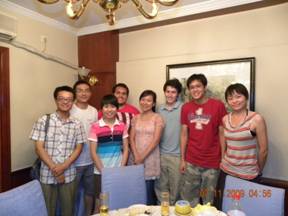
Figure B3: The welcome dinner
The volunteers welcomed us to Tsinghua University and they were happy to be part of the program.
Campus Environment
Housing
We were placed in the Zijing foreign student appartments. Each of us had our own room and each room was supplied with a desk, chair, bed, closet, television, phone, internet port and a restroom. The dorm building has approximately twelve floors and each floor has approximately thirty rooms, one laundry room, two rooms for drying clothes, a meeting room and one kitchen room. The first floor has the receptionist and the bike storage areas.
We separately had to buy an internet account to use the internet and we had to purchase a laundry key to use the laundry room. Room service was also provided for us and hot water was provided during three time periods a day.
Transportation
Our main source of transportation was our rental bicycles. The size of the campus limited us from simply walking. It would take too long to simply walk from one side of the campus to the other. Using bicycles was a more convenient way to travel.
Bicycle lanes were placed throughout the campus and some areas were closed-off to outside traffic. There were also plenty of repair shops just in case we got a flat tire or a broken chain. There were also many bike rental stations throughout the campus.
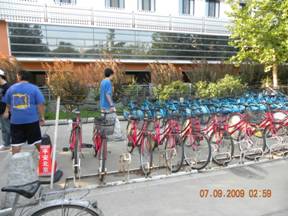
Figure B4: Bike rental station
We were able to exchange our bikes at these stations at anytime if we encountered any problems with the bikes we were using. Taxis were also found throughout campus. We only used taxis when we traveled outside of campus and our destinations were far outside the campus that using a bicycle was impractical.
Recreation
There are several basketball courts, tennis courts, volleyball courts located throughout campus and three sports fields that are equipped with soccer fields and tracks. The campus also has two swimming pools, a Sports center, a gymnasium and a ping-pong gym.

Figure B5: The bowling alley at the recreational center
Finally there is a recreation center that has bowling alleys and pool tables. Most of these are located near the dorms and our apartment.
Food
There are three student dining halls in Tsinghua University. In order to get food we needed to obtain a meal card and deposit money into the account. We inserted this meal card into a card machine that would deduct the price of the meal from our remaining balance on the card. Each building had a card center were we could add additional funds if the balance on our cards was low.
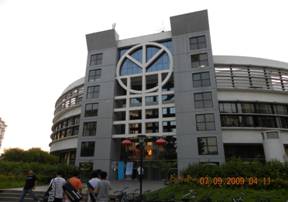
Figure B6: Taoliyuan Dining Hall
The Taoliyuan dining hall is where we spent the most time in because it was the closest dining hall to our apartments. This dining hall has three floors including a basement and with each floor serving their own unique foods. The basement was more like a restaurant where you choose your food from a menu and it's the floor where the Qingqing pizzeria is located. The other floors had different stations and each station served a particular style of food. Each floor also had their fruit station, bread station and drink station. It was only a matter of telling the chef at the station what food we wanted. The first floor offered more western types of food along with Chinese food and the second floor mainly offered Chinese food. We would go to the first floor for breakfast, the second floor for lunch and we would have dinner outside of campus. The third floor consisted of a decent restaurant that students would go to if they did not like the cafeteria setting.
There are four food establishments that deliver food on campus. We did not get the chance to use this service but it was good to know that we could use it.
Besides the dining halls, there are three supermarkets. The only supermarket we went to was the located on the basement first floor of Guanchouyuan and this supermarket has a wide selection of food, snacks, fruit, drinks electronics, clothing and bathroom items. This supermarket was very convenient for us because it was open all day unlike the dining halls which were only open at specific times of the day.
Sightseeing
The Forbidden City
The Forbidden City was one of the first places we went to see. Our volunteer Bing Yan took us there. We rode our bikes from our dorm building to the subway station and took the subway to The Forbidden City.
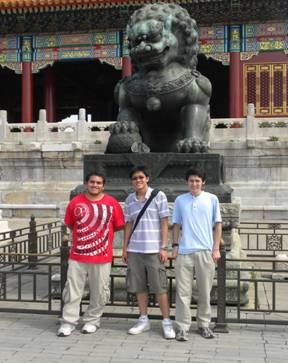
Figure B7: Inside the Forbidden City
The Forbidden City was one of the most difficult places to enter because of the large number of people entering through a narrow entrance. This was truly a magnificent place; there were several dragon statues along with mini museums located throughout the place which displaced many ancient artifacts. But the most impressive feature of the city was its size. It did not become apparent to us until we reached the middle of the city while believing that the exit was close at hand. We were shocked when our volunteer Bing Yan told us that it was only the half way point.
We were unfortunately unable to explore the whole city. We missed breakfast that day and by the time we finished exploring the center and left parts of the city we were too tired and hungry to go on.
Bird's Nest
Our volunteer Lei Guo took us to the Bird's Nest. We also rode our bikes from our dorm building to the subway station and took the subway to the Olympic National Stadium.
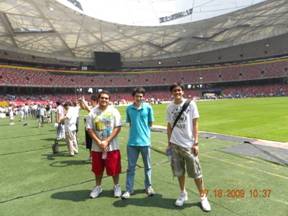
Figure B8: Inside the Bird's Nest
We were astonished by the size of the stadium and the large number of people attending. We saw people from all over the world and had friendly conversations with a few of them. We took a moment to take a seat and enjoy the view. It took us a while to locate the torch once we were inside because it was in its lowered position. We circled the stadium a couple of times from the inside before exiting the stadium to locate the torch from the outside.
The Great Wall
We saved the best for last. Unlike the other places we visited the Great Wall was not accessible by subway. We had to take a taxi to a bus station that was specifically dedicated to taking people to the Great Wall. Our volunteer Xin Liu led the way and we rested on the two hour bus drive.
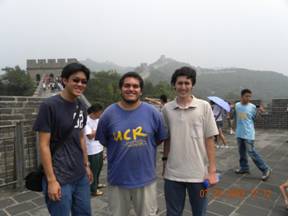
Figure B9: The Great Wall
Reaching the Great Wall was difficult. Due to the large amount of traffic heading to the entrance of the wall, we had to get off the bus three kilometers away from the entrance. We had to get off because the traffic flow was so slow that walking was much faster.
Our goal once we reached the entrance to the Great Wall was to climb to the highest point. It was very challenging experience to reach the highest point. The obstacles we faced were crowded areas, steep inclines and uneven steps. We took several breaks along the way and we even saw a roller coaster on the side of the Great Wall. It was something that we never thought we would see there.
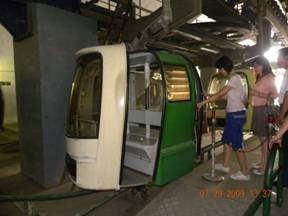
Figure B10: The cable cars located at the Great Wall
We finally reached the highest point after a lot of hard work and we were very satisfied that we accomplished our goal. We decided not to climb down the wall but to instead take a cable car that was located nearby due to time constraints.
Institute of Microelectronics
Gate Optimization for Space Applications Seminar
We were invited to attend a seminar held by alumni professor Guofu Niu from Auburn University in Alabama. Professor Niu's main focus was on optimizing Silicon (Si) and silicon-germanium (SiGe) gates for space applications. One of his approaches was to use cryogenics. The result of using this method is that the gates can handle large temperature changes but current gain declines substantially. To improve it, he suggests using a smaller bandgap, but that puts a limit on how much SiGe can be used because it could cause more defects.
He says that for unoptimized gates, low or mid-temperatures are good but high temperatures are bad. The problem is that a heterojunction barrier forms and it becomes thermally sensitive, both are bad. He suggests one possible solution is to add more germanium (Ge) but a new problem arises from that. Adding too much Ge causes instability.
He then states that the barrier effect is not the problem and goes on to speak about a transit time hump. He suggested again to add more Ge to eliminate the hump. To do this, he made a new gate profile and made a new shape. This worked to get rid of the hump and it highly extended the failure temperature range. On the other hand, he lost some peak performance but increased the performance range overall.
He then goes on to speak about compact modeling to make the circuit perform over a wide range of temperatures. He said that compact modeling causes the Shockley theory to break. So he used technology computer-aided design (TCAD) to make a new model but it didn't work. So he used the Phillips model but it also didn't work. He then decided to use an approximate model but the test failed. So he decided to Google search for every formula and found the Altermatt model. This model also didn't work, but it was closer than the other ones. He then experimented with the configurations and managed to produce decent working results.
Clean Room
We had an opportunity to visit their clean room on campus and it was our first time entering one. We took several precautions before entering the laboratory. We had to remove our shoes and place them in a small storage area. We were then given sandals, feet covers, and full body suits that covered our entire body from head to toe. The suit even had a hood to cover our heads. Our faces and hands were the only body parts not covered by the suit. Finally, we individually stepped into a chamber that air blasted us for about thirty seconds in order to remove particles that could potentially contaminate the lab.
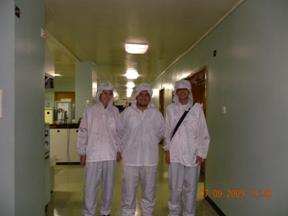
Figure B11: Inside the clean room
There are several rooms in the laboratory and each room is specialized for specific tasks. One particular room we visited was the chemical room. This room housed various types of chemicals. Lab workers use this room to clean tools and equipment, and to test the effects of foreign solutions on test samples.

Figure B12: The chemical room
We needed to take great care when entering this room because it had a greater risk than all other rooms. The room housed some hazardous chemicals that could cause serious injury to someone. Luckily we did not encounter any problems.
Another room in the laboratory had special lighting conditions. This room is used to test samples that are sensitive to normal lighting conditions. Normal light could potentially damage the devices, change the chemical properties, and affect the data collected from them.
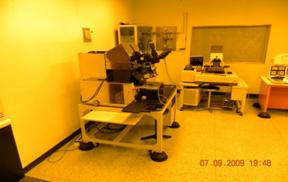
Figure B13: The special light room
From figure B13, it can be seen that the lighting used in the room is very different from the normal lighting used in other rooms. The only negative aspect about this room that we found is that it took out eyes some time to adjust after we exited the room. We were also momentarily disorientated as we exited the room but we spoke to people who have been working in the room and they said that it doesn't take long to get used to it.
The other rooms have specialized equipment such as mass spectrometers and electron microscopes. We got the opportunity to examine wafers using the equipment in the lab.
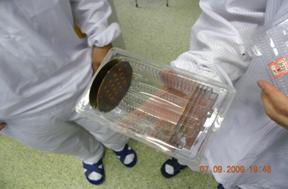
Figure B14: Picture showing wafers
With the help of a probe station, we were able to clearly see the architecture and the several layers on the wafers. We got to see the skill that is required to place the probes on the wafer to provide power. It took one of the lab workers several attempts to properly place the probes. After successfully providing power, we got to observe the response on a multi-meter.
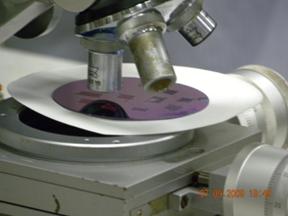
Figure B15: A wafer on a microscope
Tire Pressure Circuit Sensor
We were invited to a demonstration of a tire pressure circuit sensor. The students working on the circuit said that this was their fourth year working on it and that several versions of the sensor have been created. The latest version of the sensor itself is 2mm x 2mm and the chip on it is 1mm x 1mm.
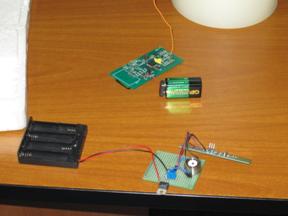
Figure B16: Pressure sensor(bottom) and pressure display circuit(top)
For the demonstration, the sensor was placed in a vacuum container and securely sealed. A pump was then used to change the pressure inside the container. The pressure sensor wirelessly transmitted the pressure information to a circuit that displayed the pressure inside the container.
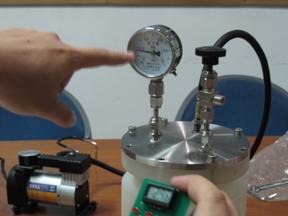
Figure B17: Comparing pressure readings
We then compared the pressure readings on the display to the pressure readings on the vacuum container. The readings on the display closely matched the readings on the container.

Figure B18: Preparing the pressure sensor setup
One of the major problems with the latest version of the pressure sensor is the power supply. Not enough power is stored in a single battery to power the device. For this experiment, four AA batteries are used to power the pressure sensor and a 9-volt battery is used to power the display circuit. The reason that these power supplies are not ideal is because they are bulkier than the pressure sensor and doesn't last long enough to be practical. Test results show that the latest version has a two year life span before a battery change is needed but the ideal life span for the power supply is seven years. Currently, the students are working on a solution to try to solve these problems.

Figure B19: Attending the sensor demonstration
The students believe that in the future, these types of sensors will monitor the pressure of the tires and they will alert the driver if any problems arise.
Introduction // Hangzhou // Beijing // Conclusion
(c) 2009 University of Califronia, Riverside
Website Design by Cody Lewis